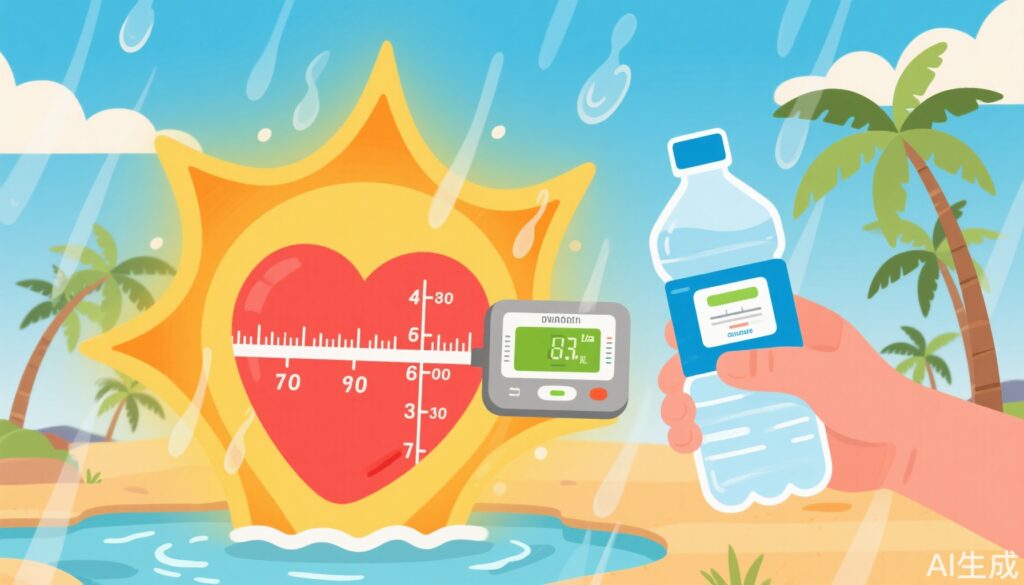Understanding the Impact of Heat and Humidity on Heart Health
In hot and humid environments, it is essential to take care of your heart’s health. Medical studies have shown that when environmental temperatures exceed 32°C and humidity levels rise above 60%, the cardiovascular system begins to experience additional stress. This is because, under these conditions, the body activates a complex cooling mechanism that heavily involves the cardiovascular system.
As environmental temperatures approach or exceed skin temperature (approximately 33-35°C), evaporative cooling becomes the sole effective means of lowering body heat. During this time, the body expands skin blood vessels to increase blood flow—skin blood flow can soar from about 500 ml/min at normal temperatures to 7000-8000 ml/min in high heat, equivalent to the entire body’s blood completing a “skin circulation” in just a few minutes. This redistribution of blood presents a dual challenge: on one hand, the heart must increase its output by 40-60% to maintain this high flow; on the other hand, blood supply to internal organs (including the heart itself) is relatively reduced. For healthy individuals, this may only result in slight discomfort but for those with cardiovascular disease or the elderly, these changes can have more severe consequences.
Furthermore, in high-temperature environments, humans can lose 500-1000 ml of fluid through sweating every hour. When fluid loss reaches 1%-2% of body weight, blood starts to thicken, increasing viscosity and requiring the heart to exert more effort to push blood around. Additionally, the loss of electrolytes (especially sodium and potassium) can disrupt electrical signal transmission in heart muscle cells, increasing the risk of arrhythmias. The American Heart Association indicates that without timely rehydration, exposure to high temperatures for just two hours can increase blood viscosity by 8%-12%.
Recognizing Four Early Warning Signs
It is crucial to promptly identify early signals of heat-related cardiac issues, including:
1. **Chest Tightness or Pressure**: Unlike general breathlessness, this discomfort typically occurs behind the sternum and may radiate to the left arm or jaw;
2. **Excessive Fatigue**: Intense tiredness that exceeds what could be explained by environmental temperatures, which does not alleviate with rest;
3. **Palpitations**: A sensation of a racing heart (>100 beats/min), skipped beats, or irregular heart rhythm;
4. **Dizziness or Fainting**: An indication of insufficient blood flow to the brain, potentially resulting from reduced cardiac output and lowered blood pressure.
It’s important to note that the elderly, diabetes patients, and those with chronic hypertension may exhibit “silent” symptoms. Due to decreased sensitivity of nerve endings, these individuals may not experience noticeable discomfort until serious complications (such as acute coronary syndrome or severe hypotension) arise. Therefore, during hot weather, this group should be especially vigilant in monitoring blood pressure and heart rate—even in the absence of typical symptoms.
Four Essential Heart Health Tips
When faced with hot and humid conditions, follow these four heart health recommendations:
1. **Environmental Management**: Adjust your outdoor activity plans when the forecast shows a “feels-like temperature” exceeding 37°C; use a dehumidifier to maintain indoor humidity below 50% to significantly reduce cardiovascular strain; ensure your bedroom temperature does not exceed 28°C during the night as high temperatures can increase the risk of heart attacks by 40% upon waking.
2. **Physiological Monitoring**: Measure your resting heart rate at the same time each morning; if it increases by more than 10 bpm, it indicates poor heat adaptation. Observe urine color; it should ideally be light lemon yellow, while dark coloring points to dehydration. Those with pre-existing health conditions should monitor blood pressure more frequently, with caution if systolic pressure fluctuates over 20 mmHg.
3. **Behavioral Interventions**: Adopt a “small and frequent” hydration strategy, consuming 200-300 ml of electrolyte-containing warm water every hour (e.g., adding a small amount of salt to warm water to replace sodium). Avoid sudden transitions from high-temperature environments to cold air-conditioned rooms, as temperature differences exceeding 10°C may trigger coronary spasms. Opt for breathable, cool-touch fabric clothing to lower skin temperature by 2-3°C.
4. **Nutritional Support**: Increase intake of potassium-rich foods (such as bananas, spinach, and avocados) to combat fluid loss; avoid high-fat diets (such as foods high in oil and fried items including nuts, sesame, peanuts, fried foods, fatty meat, organ meats, and cream products) to lessen heart burden.
Remember, when you’re drenched in sweat, your heart is working hard in silence—give it the attention and care it deserves, and navigate the hot and humid weather safely.



